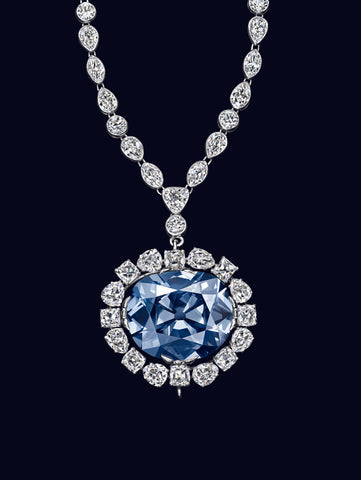
_____________________________________________________________________________________________________________________________
El Diamante Hope
Como les comenté la semana pasada, el Diamante Hope, es un diamante de color azul marino, con un peso estimado en 45.52 quilates.
Con el paso del tiempo, se ha vuelto legendario por la supuesta maldición que alcanza a sus respectivos poseedores. Numerosos rumores señalan que es el culpable de las desgracias que les ocurrieron a cada uno de sus dueños.
El primer poseedor de la joya fue Jean-Baptiste Tavernier, quien consiguió la misma en India y llevó el diamante original (cuyo peso se estimaba en 115 quilates) al rey Luis XIV de Francia. Después de venderlo, Tavernier cayó en la quiebra y huyó a Rusia, donde sería hallado muerto de frío y su cadáver devorado por alimañas.
En el año 1691, madame de Montespan, amante del rey, quiso que Luis XIV le obsequiara con el diamante. Poco después, cayó en desgracia y murió olvidada en 1707. (¡Yo más bien creo que fue Karma por andar de amante! 😆)
En 1715, durante la visita del embajador del sha de Persia, el rey de Francia le mostró el diamante, para que viera que el objeto no podía hacerle ningún mal. Luis XIV murió ese mismo año, de manera inesperada. Con su muerte, muchas personas comenzaron a creer que el diamante (todavía no había pertenecido a la familia Hope; su nombre en ese entonces era "diamante azul") causaba desgracias a su poseedor. El siguiente rey, Luis XV de Francia, no mostró mayor interés en la gema y ordenó conservarla en un cofre. (¡Uff que suerte!)
Ya en 1774, María Antonieta, esposa del rey Luis XVI de Francia, decidió portar el diamante y prestarlo a la princesa de Lamballe. Debido a que María Antonieta y su esposo murieron en la guillotina y la princesa fue brutalmente asesinada a manos de una muchedumbre enardecida, se ha atribuido también al diamante azul el asesinato de estos. (¿Qué horrible no?)
Durante la Revolución francesa, unos ladrones robaron el diamante de la colección de joyas reales. Solo uno de ellos lo conservó hasta 1820, cuando decidió vendérselo al holandés Wilhelm Fals, para cortarlo en dos. La primera joya fue adquirida por Carlos Federico Guillermo, duque de Brunswick quien más tarde cayó en la quiebra. La segunda la conservó el holandés. El hijo de Fals optó por robarle la joya a su padre y venderla al francés Beaulieu. Se atribuye al hurto de la joya la muerte de Fals y su hijo, quién se suicidó tiempo después. (Eso les pasa por robársela)
El rumor de las desgracias atribuidas a la supuesta maldición, concluyó en que Beaulieu vendiera el diamante a David Eliason, quien también la vendió rápidamente al rey Jorge IV de Inglaterra. La muerte del rey se atribuye también al uso del diamante, que había sido incrustado en su corona.
En 1824, el diamante reapareció en el contexto histórico, al formar parte de la colección de gemas de Henry Phillip Hope. En ocasiones, Hope solía portarlo en una fíbula o se lo enviaba a Louisa Beresford, esposa de su hermano Henry Thomas Hope, quien lo usaba para algunos bailes formales. Tras la muerte de Phillip Hope, acaecida en el año 1839,
La gema pasó a ser heredada por cada uno de los descendientes de la familia Hope. Su descendiente Francis Hope fue el ultimo en recibirla. En el año 1896, Hope se declaró en quiebra y, como era incapaz de vender el diamante Hope sin el permiso de la corte, su esposa lo apoyó económicamente. Fue hasta el año 1901 cuando, finalmente, Hope pudo vender la gema, al año siguiente Francis se divorció de su esposa.
El siguiente poseedor del diamante fue el príncipe Iván Kanitowski. Kanitowski obsequió el diamante a una vedette, a quien días después asesinaron. Los siguientes propietarios de la joya, el griego Simón Montarides, Abdul Hamid II y la familia MacLean, también tuvieron muertes trágicas, (historias muy tristes que no incluí porque se hace muy largo este mail) la mayoría de ellas aún atribuidas al uso del diamante Hope.
A partir de entonces, se ha vuelto legendario por la presunta maldición que alcanza a sus respectivos poseedores.
El 10 de noviembre de 1958, fue donado al Museo Nacional de Historia Natural de la Institución Smithsoniana por el joyero estadounidense Harry Winston, quien lo envió, en un sobre de papel de estraza, por medio del servicio postal nacional. A partir de entonces, forma parte de la colección nacional de gemas del museo.
Britt, ¿Te gusto esta mail? Si te gusto te pido me lo hagas saber. Si no te gusto igual házmelo saber también ya que preparo estos mails con mucho cariño para que los disfrutes!
Xoxo, Britt

